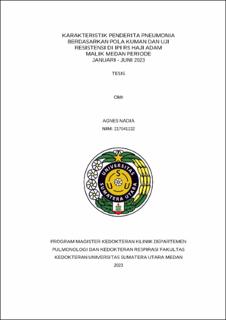| dc.description.abstract | Background and Objectives: According to global estimates, mortality in the Intensive Care Unit (ICU) ranges from 6% to 40% when specialized medical care is applied. Results from several studies conducted in Iran indicate that ICU mortality rates range from 27.9% to 33.7%. Mortality rates always refer to recorded biological deaths in the ICU. Several studies have been conducted to identify factors that increase the risk of mortality in the ICU; patients in the ICU who require a ventilator for more than 14 days, patients older than 65 years, septic shock, patients with kidney and heart disorders, and nosocomial infections are factors that increase mortality in the ICU. Data on microbial pattern examinations in the ICU based on Bronchoalveolar Lavage (BAL) examinations are still very limited, especially in Indonesia. Therefore, based on the above background, the researchers were interested in conducting research on the "Characteristics of inpatient Pneumonia cases at H. Adam Malik Hospital Medan based on microbial patterns and resistance testing in Bronchoalveolar Lavage (BAL) examinations."
Methods: This research is a descriptive analytical study to examine the characteristics of pneumonia patients based on microbial patterns and resistance testing in ICU Haji Adam Malik General Hospital Medan.
Results: Most pneumonia patients were male, with 33 individuals (71.7%), and 13 individuals (28.3%) were female. The majority of pneumonia patients were in the 41-60 age group, with 21 cases (45.6%), and the least occurred at the age of 20 with 2 cases (4.3%). The most common microbe in pneumonia patients was Acinetobacter baumannii, with 17 patients (27.4%). The most resistant drugs for Acinetobacter baumannii were Cefepime (94%), Ciprofloxacin (94%), and Gentamicin (94%), while the most sensitive drugs were Tigecycline (35%), Amikacin (29.4%), and Trimethoprim/Sulfamethoxazole (17%). The most common MDRO-causing microbe in CAP patients was Acinetobacter baumannii, with 7 cases (100%), and Klebsiella pneumoniae ssp pneumoniae with 4 cases (80%). The most common MDRO-causing microbe in HAP patients was Acinetobacter baumannii, with 6 cases (100%), and Klebsiella pneumoniae ssp pneumoniae with 2 cases (75%). The most common MDRO-causing microbe in VAP patients was Pseudomonas aeruginosa with 4 cases (66.6%), and Acinetobacter baumannii with 4 cases (100%). The microbe most sensitive to drugs was Pseudomonas aeruginosa, with 5 cases (35%).
Conclusion: The most common microbe causing pneumonia in the ICU at Haji Adam Malik Hospital is Acinetobacter baumannii. The most resistant drugs against Acinetobacter baumannii are Cefepime, Ciprofloxacin, and Gentamicin, while the most sensitive drugs are Tigecycline. | en_US |


